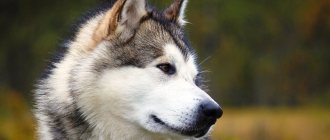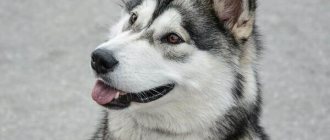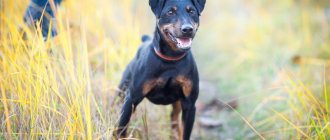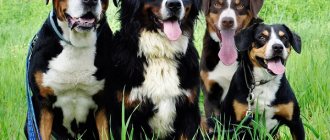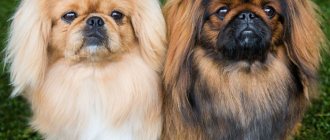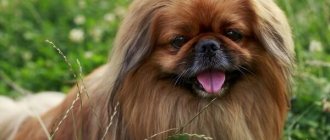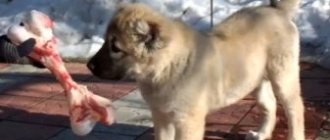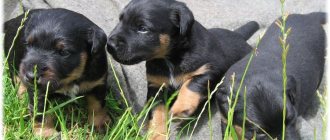06/14/201906/14/2019 Irina Malinina 0 comments
The German Jagdterrier is a small hunting dog bred in Germany and is a versatile hunter. The dog is used in burrow hunting and also works well in water and on land.
A Jagdterrier dog will never become a fully indoor and “sofa” dog. This is a strong and strong-willed animal, has a hot temperament and is distinguished by amazing working qualities.
History and standard
The Jagdterrier breed is still quite young - it is not even 100 years old. The ancestors of these dogs were German and English fox terriers. At the beginning of the last century, a group of enthusiastic hunters decided to create the ideal burrowing dog breed.
At the beginning of the experiment, German purebred black and light English fox terriers were mixed. Black and tan puppies were born. At the next stage, the selection was led by Dr. Herbert Lackner.
As a result of serious breeding work and successful crossings with Old English Terriers and Welsh Terriers, the Black and Tan Terrier was born in 1925, which had a powerful hunting instinct and excellent working qualities. The dog was distinguished by courage, pressure, and a fighting character. At the same time, she was surprisingly balanced and faithful. The breed was named Jagdterrier (German Jagdterrier).
In 1926, the first club for lovers of these animals was registered in Germany. The breed was officially recognized in 1981. At the same time, an international standard was developed.
Brief history of origin
The hunting terrier was first bred at the beginning of the 19th century by German breeders, but not everything went smoothly: ancient beliefs and prejudices of experienced hunters did not accept the multi-colored breed, because it would not bring good luck during the hunt.
The basis for breeding a new hunter were: German toy terrier, pinscher, several varieties of dachshund and fox terrier, while strict appearance was not considered a priority.
On a note. The German breeder Walter Zanzenberg believed that appearance was a secondary issue when breeding a new breed of burrow hunter, so he took fox terrier puppies as a basis, which became the progenitors of the new breed of German Jagdterrier.
The main task of the small dog was to track the animal: to find its shelter and drive the animal out of the hole or strangle it and carry it to its owner. The possibility of following hares along the trail was also taken into account. Given its small size and special rage during the rut of the beast, the Yah Terrier became an excellent tracker.
Already in the 30s of the last century, German dog handlers managed to establish the first standards for a small hunting dog, which are used all over the world today.
Many users incorrectly call this unique breed of fearless hunter: Yak Terrier, Yah Terrier or Young Terrier, but there is only one correct name - Jagdterrier or German Hunting Terrier.
Description
A small, muscular dog with a somewhat elongated format, a dry and strong build, dense bones and an elongated head.
The height of an adult is no more than 40 cm (males) and 38 cm (females). Weight - from 8 to 11 kg.
The Jagdterrier (the photo of which you see in our article) has a thick, smooth and rather coarse coat, with a dense undercoat. There are two types of animals - smooth-haired and rough-haired.
These varieties differ only in the quality of their hair, and therefore are considered one breed. Wire-haired individuals have longer hair on their ears and paws, and they also have a beard.
The standard allows three colors: dark brown, black and gray-black with tan. A few years ago, the standard allowed a brown and tan color, but today such animals are not allowed for breeding. Despite this, puppies with such a fur coat are born from time to time. Animals have strong bones and powerful muscles.
Breed Features
Jagd is a strong and hardy dog. This breed was first bred almost 100 years ago in Germany. Today there are two types - wire-haired dogs (with a beard on the face) and smooth-haired dogs (without a beard). Representatives are small in size: males grow up to 40 cm, females - up to 38 cm, the permissible weight is 11 kg.
A dog's cute appearance is very deceiving. Yagdas are distinguished by a very strong, strong-willed, stubborn character, which the owner should subordinate from the first days the puppy appears in the house. Training will require a lot of effort and patience, but if you try in the first months, you will get a reliable, adequate, and faithful dog with which there will be no problems in society, at home, or while hunting.
From the first days in a new family, a dog strives to gain authority over its owner and subordinate him to his habits and character. To prevent this from happening and to correctly build the “master-dog” vertical, it is important to devote a lot of time to training. The best option would be to contact professional dog handlers who will help you understand the characteristics of the breed and show you the basic principles and methods of training.
The Jagdterrier dog is very suspicious of strangers. For some time he will carefully observe the one who first came to his house. And if he sees that the guest is too close to the owner and may pose a danger, the dog will definitely react to protect.
Have you already tried it and it doesn’t help?
Enroll in an online school and solve your problem right now!
more details
Yagdas rarely make friends with other animals, and any attempts to dominate them are nipped in the bud. The exception is when they grew up in the same house with another dog or cat. If you do not raise a Jagdterrier from childhood, then in adulthood it can cause a lot of trouble and problems for the owner. If you do not “crush” a representative of this breed with authority in a timely manner, the dog will become uncontrollable, uncontrollable, and, despite its small size and cute appearance, will turn into a wild beast.
If we consider Yagda as a hunter, then in this case he has no equal. When hunting large and small animals, birds, representatives of this breed will show their fearlessness, endurance and strength. They are not afraid of bears or wild boars. They are strong and independent, and can walk for hours in the forest away from their owner. In order for a dog to be adapted for hunting, it is important to educate it in a timely manner, and most importantly, correctly. Otherwise, the combination of hunting passion and lack of training can lead to tragedy. Training must be strict and consistent, with strict adherence to rules regardless of the situation. This is the only way to get an easily manageable, socially adapted Jagdterrier.
Wool and its care
Regardless of the type of dog's coat, it perfectly protects the animal from bad weather. The smooth-haired Jagdterrier has short, even hair that fits tightly to the body. In a wire-haired animal it is longer, but fits just as tightly to the body. One more subspecies should be highlighted - the rough-haired Jagdterrier. The characteristics of the breed apply to it in full. Except for wool. It has two layers. The top one is very dense and wire-like in structure. A very dense and short undercoat is the second layer. The hair on the face is longer, creating the characteristic eyebrows and beard of this breed.
The Jagd Terrier dog needs regular brushing (at least once a week).
Character
This is a completely fearless and determined dog. Nature has rewarded her with an aggressive attitude towards predators and burrowing animals. The Jagdterrier, photos of which can so far only be found in special canine publications, has a rather complex character. He is distinguished by his inflexibility and will, his character is quite stern. Dogs are very wary of strangers, but they are not timid and do not show unjustified aggression. They love their work (hunting) very much and get true pleasure from it.
The Jagdterrier, whose breed characteristics position it as a very severe creature, becomes attached to its owner with all its soul and becomes infinitely devoted to him. They pointedly ignore the rest of the family.
The Jagdterrier dog can be very stubborn, but it is always active, full of life, extremely energetic, and sociable with its owner.
The Jagdterrier, whose reviews are quite controversial, can get along with children. This only happens if they do not offend the animal and do not bother them with excessive attention. Since this dog has a strong hunting instinct, relationships with other pets do not work out. It follows from this that these animals need socialization, and at an early age, and systematic training. In the absence of education and proper control, they are prone to vagrancy.
Jagdterriers are real hunters. They are distinguished by subtle instincts and boundless courage. This is a complex dog that needs strict training. It is not suitable for a novice dog owner.
The Jagdterrier is famous not only for its outstanding hunting characteristics. The characteristics of the breed indicate its excellent guard instincts.
Training and coaching dogs
Raising jags begins with establishing contact. The owner must understand that he is not taking into the house a lap dog, but a dog prone to aggression. This breed is known for having its own opinion: jags often make it clear how they feel about their owner’s decisions. Jagdterrier puppies have a hard time getting into training. They need to be clearly shown what is required of them. At the initial stage, consistency is very important. The owner must persistently and regularly teach the baby commands.
To teach a puppy not to bite, it is necessary to establish the nature of the bites. Kids often try everything to their teeth - this is their way of exploring the world. If the owner notices signs of aggression, action must be taken immediately. The baby is shown unacceptable behavior: you can squeal, pretend to cry and walk away from him. The dog will understand that the owner is showing negative emotions and will try to restrain himself. You can also offer her toys that are allowed to chew. If the puppy thereby declares its superiority, it is better to contact a dog handler. It will no longer be possible to control the aggression of an adult dog. At 6 months, the dog is taken to special training and prepared for descent into the hole. From 6 to 8 months the battle of authority begins. The puppy tries to set rules and learns the boundaries of what is permitted.
The best age for training an animal is from 8 months to 1.5 years. The training begins with a descent into the hole. A tunnel made of boards and bricks is used as a simulator. The animal is released into an improvised hole, and the dog is expected to respond. If a dog rushes after prey without a command from its owner, it means it will become an excellent hunter. After training with the hole, they are then introduced to potential victims: the dog is shown a raccoon or a fox sitting in a cage, waits for signs of aggression, and releases the bait into the hole. Then the dog is released.
To make a yagd angry, it is necessary to encourage his natural aggression and interest in the beast. It is recommended to introduce the dog to different types of game so that it can attack any prey without fear. If the owner does not plan to use the yagda as a ruthless hunter, training at home is suitable for him. There are many videos and text guides, but none of this can replace communication with a dog handler. The German Terrier is a complex and explosive dog that needs early and systematic training.
Hunting with a German Jagdterrier
Representatives of this breed are trained to hunt animals from childhood.
Hunting with Jagdterrier is carried out:
- To the boar. The most commonly used method is a round-up: a pack of dogs surrounds the animal in a tight ring, which allows the hunter to make a shot. Traiting a Jagdterrier to a wild boar begins after two years of age.
- For a hare. The dog, noticing the hare, begins to chase it. Jagd cannot reach the speed of a hound, so attempts are often in vain.
- For a badger. The dog finds a badger hole and dives into it to get the animal. If the badger is really there, the yagd signals the find with a loud bark. He will try his best to drive the animal out of its hiding place. Sometimes dogs get so stuck in the ground that hunters have to dig them out.
- On the fox. Fox hunting takes place in complete silence. You should also not cast shadows on the hole. If the fox senses danger, it will use an extra move or will desperately fight the dog. The Jagdterrier must fight in such a way as not to damage the fur of the prey.
- To the beaver. The dog, at the hunter’s signal, begins to dig out the den. Jagd spends a few minutes on this. To prevent burying its prey, the dog barks loudly - this paralyzes the victim and gives the dog a few extra seconds. After which the terrier drives the beaver out or strangles it right in the hole.
Jags are not afraid of water and will help the owner track ducks. These dogs are characterized by increased curiosity, so they cannot resist the reed thickets: suddenly prey is hidden in them. At the same time, the hunter must restrain the gambling dog. Terriers can get overly excited and try to catch the ducks themselves.
For successful bird hunting, it is recommended to give the fetch command not only from the shore, but also from the water. This will teach the dogs to pick up shot ducks.
Health
The Jagdterrier, whose price is quite high, is naturally endowed with good health. Of course, injuries during hunting or sports cannot be ruled out. But representatives of any other breed are not immune from this. In addition, the dog can get an infectious disease. To prevent them, it is necessary to follow the vaccination schedule.
Fortunately, these animals are practically not susceptible to genetic diseases that lead to a certain hereditary predisposition. This reassures us that with proper care, your pet will live for quite a long time.
Some more facts about berries
The Jagdterrier, or as it is also called, the German terrier, is a breed that is not fussy in food and care. You can feed them with ready-made dry food, or self-prepared food with a high content of meat and offal.
Dogs of this breed have virtually no genetically transmitted diseases. However, this does not mean that you can forget about visiting the veterinarian. No, the dog requires responsible care. Compliance with a diet, vaccinations, and regular examination by a doctor are mandatory without exception. After each walk, especially in forest areas, it is necessary to inspect the Jagdterriers for the presence of parasites, injuries and wounds, and if found, immediately provide first aid.
The activity and endurance of dogs require long walks with them outside and games at home. This is not a couch breed. You need to walk your dog for at least two hours so that it can expend its energy. Otherwise, get ready for the dog to chew and destroy everything that catches his eye at home.
Maintenance and care
The Jagdterrier (reviews from dog breeders convince us of this) does not require complex care. As already mentioned, once a week it is necessary to comb the dog’s fur so that it does not get tangled and has a beautiful and healthy appearance.
The animal should be bathed as soon as it gets dirty, as well as after being in an open body of water. In addition, it is necessary to regularly clean the animal's ears and teeth. If the claws do not grind down on their own, they should be trimmed.
The Jagdterrier requires significant daily exercise. He feels more comfortable in a large yard, where the dog can run independently as much as he needs. When kept in an apartment, the animal becomes restless and very restless. In addition to freedom of movement, the Jagdterrier needs attention and love.
Pros and cons of the breed
This breed is suitable only for energetic people who prefer an active lifestyle and know about the rules of care and the nuances of raising German hunters.
| Advantages | Flaws |
| Tireless fighter and fearless hunter | Aggression towards other animals |
| Miniature sizes allow you to feel confident in burrows | Explosive character |
| There is no innate predisposition to common diseases in dogs | Difficulty of training |
| High endurance and indifference to weather conditions | Will chew on everything it can reach if the necessary physical activity is not provided |
| Furious pursuit of the beast to the end | |
| Unique devotion to the owner | |
| Can make independent decisions | |
| Excellent makings of a born guard |
This freedom-loving dog breed is truly happy only during the hunt, where it can use the skills that nature has endowed it with.
In a family where there are no avid hunters, the Jagd Terrier may behave inappropriately. Even constant walks for several hours will not be able to release all the energy that exists within this tireless pursuer of prey.
If the dog’s owner is ready to devote all his free time to his beloved pet, to take him to a site specially equipped for burrowing breeds, where all conditions are as close as possible to real hunting, then the Jagdterrier will feel good in a city apartment.
Favorite work"
We should not forget that, first of all, this is a hunting dog. It works great in holes on a badger, fox, raccoon, easily “raises” the animal, works great in water, on a wild boar, on a blood trail.
With proper training, the Jagdterrier follows all commands, except for standing and fetching heavy game. These dogs are often kept as pets, but this is only advisable if the owner is active, loves to travel, and relax in nature.
Jagdterrier training
This strong and resilient dog requires a dominant owner. However, it is better to avoid harsh training methods. Training should be carried out firmly, consistently and fairly.
The Jagd Terrier is easy to train and very intelligent. The characteristics of the breed allow us to conclude that these animals strive to fulfill all the requirements of the owner. They adapt quite easily to any conditions, change their place of residence without any problems, and feel comfortable on long hikes.
Choosing a dog
Jagdterrier puppies always look like their parents, so when choosing a baby, try to get to know them. Living conditions are important, not only for babies, but also for adult dogs.
Ask the breeder about the mental characteristics of the puppy and his state of health. You should find out what vaccinations he has had. If you need a good hunting companion, then you should pay attention to animals whose parents won exhibitions and various competitions.
Puppies should be well-fed, energetic and very active. If a puppy under one year old is too lean, this may mean that he may have worms. A thin baby may not have properly formed bones, which can be quite difficult to restore.
Pay attention to the behavior of the little Jagdterrier. If he starts resisting, actively trying to escape from your hands, twisting around, playfully attacking, then you can be sure that you will grow up to be an excellent hunter.
Vaccinations and susceptibility to disease
German Jagd Terriers are distinguished by excellent health and do not have hereditary diseases. The first vaccination is given to puppies at the age of 2.5 to 3 months, then 21 days later - repeated vaccination.
At six months they are required to be vaccinated against rabies and given a complex vaccine against several standard diseases.
Important! Vaccination should not be carried out during the period of teeth change in puppies.
When the dog turns 12 months old, repeated comprehensive vaccination is necessary. Subsequently, it is carried out annually.
If the dog is used for hunting and is constantly in contact with wild animals, then anthelmintic prophylaxis is given every three months.
Jagdterriers practically do not get sick, but they can get injured during a hunt or catch a cold during the cold season. If your hunting dog sleeps a lot or has no appetite, you should immediately contact a veterinarian.
